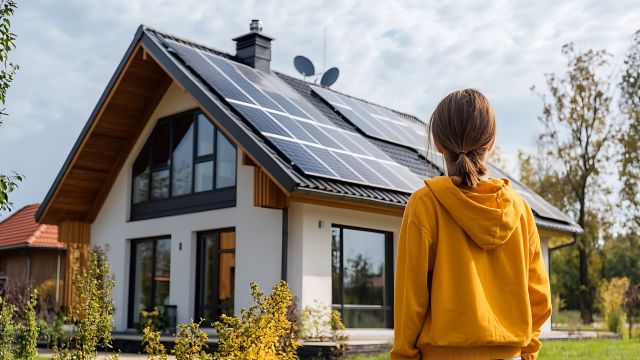The gap between solar fantasy and solar reality has left countless homeowners trapped in financing arrangements that feel more like electric company 2.0 than energy liberation.
Myth: Solar Panels Pay for Themselves in Just a Few Years
Truth: Your Break-Even Point Depends on Factors Most Sales Pitches Ignore
The payback period salespeople quote assumes perfect conditions that rarely exist in real life. They calculate based on maximum sun exposure, optimal roof angles, and utility rates that remain constant. Your actual experience will vary dramatically depending on whether you live in sun-drenched Arizona or frequently cloudy Seattle. That seven-year payback estimate can easily stretch to 15 or 20 years when you factor in your specific location, roof orientation, shading from nearby trees, and the actual financing terms you qualify for rather than the promotional rates advertised.
Installation costs create the first hurdle most people underestimate. While solar advocates love to quote national averages of $15,000 to $25,000 after tax credits, your actual price depends on your roof's condition, electrical panel capacity, and local permitting requirements. If your roof needs replacement before panels can be safely installed, add another $10,000 to $15,000. If your electrical panel requires upgrading to handle the new system, there's another $2,000 to $3,000. Suddenly that "affordable" solar investment feels less like a smart financial move and more like a second mortgage you're taking on in the name of sustainability.
Myth: You'll Eliminate Your Electric Bill Completely
Truth: Grid Connection Fees and Evening Usage Keep You Paying
Even with a perfectly sized solar system generating enough electricity to match your annual consumption, you'll still receive a monthly bill from your utility company. Most residential solar systems remain connected to the grid, which means you pay connection fees, transmission charges, and various regulatory fees regardless of how much power you generate. These fixed charges can range from $10 to $30 monthly, and they're designed to recover the utility's infrastructure costs whether you use their electricity or not. Your dream of a $0 electric bill crashes into the reality of utility rate structures engineered to ensure companies remain profitable even as more customers generate their own power.
The timing mismatch between solar production and household consumption creates another hidden cost. Your panels generate maximum electricity during midday when you're probably at work and using minimal power. Meanwhile, your peak usage happens in the evening—cooking dinner, running appliances, streaming entertainment—exactly when your panels produce nothing. Without expensive battery storage, you're selling electricity to the utility during the day at wholesale rates and buying it back at night at retail prices. This arbitrage ensures the utility profits from your solar investment while your actual savings shrink to a fraction of what you were promised.
Myth: Solar Panels Require Zero Maintenance
Truth: Efficiency Degradation and Cleaning Costs Add Up
Solar panels aren't the set-it-and-forget-it investment that marketing materials suggest. Dust, pollen, bird droppings, and environmental debris accumulate on panel surfaces, reducing their efficiency by 20% to 30% if left uncleaned. While rain provides some natural cleaning, it's rarely sufficient to maintain optimal performance. Professional cleaning services charge $150 to $300 per visit, and most experts recommend cleaning twice yearly. Over a 25-year system lifespan, you're looking at $7,500 to $15,000 in maintenance costs that rarely appear in those rosy payback calculations.
Panel efficiency naturally degrades over time, typically losing 0.5% to 1% of generating capacity annually. This degradation means the system producing 100% of your electricity needs in year one will only generate 75% to 87% by year 25. You'll increasingly rely on grid electricity to make up the difference, paying more each year as utility rates climb. Inverters—the components that convert solar DC power to usable AC electricity—typically need replacement every 10 to 15 years at costs ranging from $1,500 to $3,000. These realities transform the "maintenance-free" promise into an ongoing relationship with service providers and replacement parts.
Myth: Solar Increases Your Home's Value Immediately
Truth: Financed Systems Can Actually Complicate Home Sales
If you own your solar system outright, studies suggest it can add 3% to 4% to your home's value—but only if buyers want solar panels and understand their value. Many potential buyers view rooftop solar with skepticism, worried about maintenance obligations, roof damage risks, and being locked into an aging technology. Your investment that seemed cutting-edge when installed might look outdated 10 years later, especially as panel efficiency and battery storage improve. What felt like adding value to your home can actually narrow your buyer pool to the subset of people specifically seeking solar-equipped properties.
Leased solar systems or power purchase agreements create even bigger complications during home sales. These contracts transfer to the new homeowner, who must qualify for the lease and agree to its terms. Many buyers balk at assuming a 15 or 20-year commitment they didn't choose, especially when they discover they're locked into escalating payment rates that can exceed retail electricity costs in later years. Some buyers demand price concessions to offset the solar obligation, effectively transferring your "savings" to them while you receive less for your home. The dream of energy independence becomes a nightmare of explaining complex solar contracts to skeptical buyers who'd rather just have a house without strings attached.
Myth: Tax Credits Make Solar Essentially Free
Truth: Credits Only Help If You Have Tax Liability to Offset
The federal solar Investment Tax Credit (ITC) currently allows you to deduct 30% of your solar system cost from your federal taxes. This sounds transformative until you realize it's a non-refundable credit—meaning it can only reduce your tax liability to zero, not generate a refund. If you're retired, living on fixed income, or don't earn enough to owe substantial federal taxes, this credit provides minimal benefit. You can carry forward unused credit to future years, but that doesn't help with the upfront cash or financing costs you're managing today.
State and local incentives add another layer of complexity that sales representatives often gloss over. Some states offer generous rebates and tax breaks that genuinely improve solar economics. Others provide virtually nothing beyond the federal credit. Even where incentives exist, they're subject to annual funding caps, application deadlines, and bureaucratic processes that can delay or deny your expected benefits. The "free money" promised in sales pitches requires navigating multiple government agencies, meeting specific technical requirements, and hoping your application is processed before funding runs out. For many homeowners, the administrative burden and uncertainty around incentive timing undermines the financial projections that convinced them to install solar in the first place.
Myth: Solar Companies Are Motivated to Give You the Best Deal
Truth: Their Business Model Depends on You Overpaying
The residential solar industry operates on high-pressure sales tactics because profit margins require it. Sales representatives often work on commission, earning 5% to 10% of the total contract value. This creates incentive to maximize system size and price rather than right-size your installation for actual needs. They'll recommend a 10-kilowatt system when 6 kilowatts would adequately cover your usage, because bigger installations mean bigger commissions. The markup on equipment can reach 50% to 100% above what commercial installers pay, with the difference funding aggressive marketing campaigns and sales team compensation.
Financing through the solar company themselves typically carries interest rates and fees that dwarf any electricity savings you'll achieve. They bundle installation costs with financing charges, creating monthly payments that might actually exceed your current electric bill during the early years. The 20-year financing term ensures you're paying interest on equipment that may need replacement before the loan is satisfied. Reading between the lines of these financing agreements reveals that solar companies make more money from interest charges than from hardware sales—meaning your journey toward energy independence is actually a journey deeper into debt that profits the installer more than it benefits you.
Myth: Going Solar Is an Environmental No-Brainer
Truth: Manufacturing and Disposal Create Their Own Carbon Footprint
Solar panel production requires significant energy and resources, including mining rare earth elements, refining silicon, and manufacturing in facilities often powered by fossil fuels. The carbon payback period—the time required for your panels to generate enough clean energy to offset their manufacturing emissions—ranges from two to five years depending on where they're manufactured and installed. If your motivation is purely environmental, purchasing renewable energy credits or investing in community solar might reduce more carbon emissions per dollar spent than installing rooftop panels with questionable longevity.
End-of-life disposal presents an emerging environmental challenge that the solar industry hasn't adequately addressed. Solar panels contain toxic materials like cadmium and lead that require careful recycling. However, recycling infrastructure remains limited, and disposal costs can reach $20 to $30 per panel. With the first wave of mass-installed residential solar reaching the end of its lifespan in the coming decade, we're facing a looming waste crisis where millions of panels may end up in landfills leaching toxins rather than being properly recycled. Your environmental good deed today could become tomorrow's toxic legacy if the industry doesn't solve its waste problem soon.
Let Go of the Fantasy, Calculate Your Real Numbers
Solar panels aren't inherently good or bad investments—they're highly situational decisions that require honest analysis of your specific circumstances. The savings you'll actually realize depend on your location, electricity costs, roof condition, financing terms, and how long you plan to stay in your home. Chasing the solar dream without understanding these variables transforms a potentially smart investment into an expensive mistake.
Let go of the belief that solar representatives have your best interests at heart—they're salespeople optimizing for their commission. Release the assumption that environmental benefits automatically translate to financial ones. Stop letting the fear of missing out on tax credits rush you into a 20-year commitment you haven't thoroughly vetted.
Get multiple quotes, insist on seeing detailed production estimates for your specific location, and have an independent electrician assess your system needs. Calculate payback periods using conservative assumptions about utility rate increases and panel degradation. Consider whether that capital might generate better returns invested elsewhere. These practical steps—grounded in your actual situation rather than idealized projections—determine whether solar panels save you money or simply shift who you're paying. That's the clarity that protects both your finances and your authentic path toward sustainable living.
📚 Sources
1. National Renewable Energy Laboratory. (2024). "Residential Solar Economics: A Comprehensive Analysis." U.S. Department of Energy.
2. Lawrence Berkeley National Laboratory. (2023). "Selling Into the Sun: Price Premium Analysis of a Multi-State Dataset of Solar Homes." Berkeley Lab Electricity Markets and Policy Group.
3. Solar Energy Industries Association. (2024). "U.S. Solar Market Insight Report Q1 2024." Wood Mackenzie and SEIA.
4. International Renewable Energy Agency. (2023). "End-of-Life Management: Solar Photovoltaic Panels." IRENA Technology Report.
🔍 Explore Related Topics










